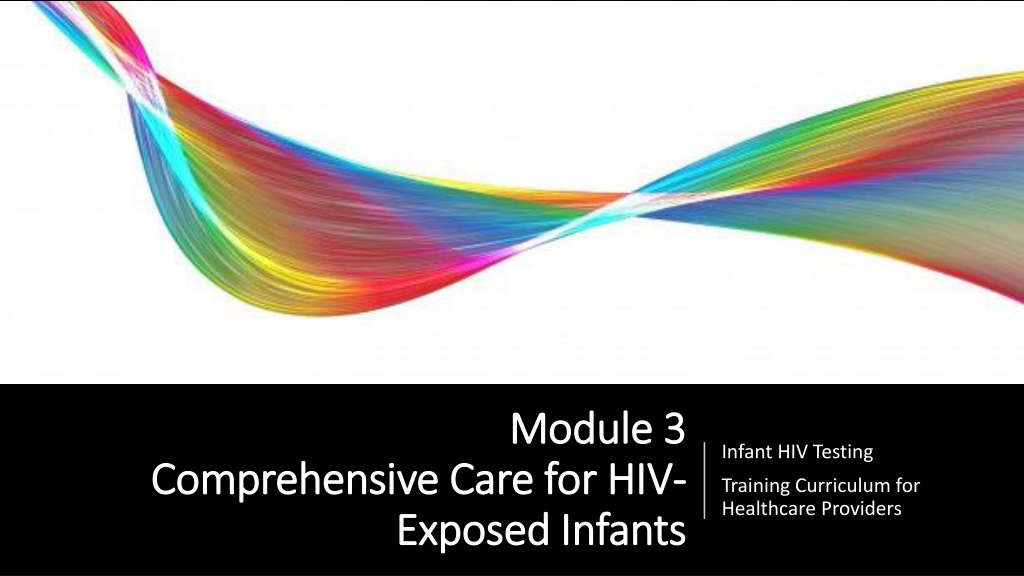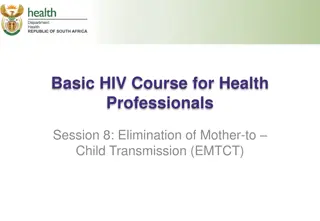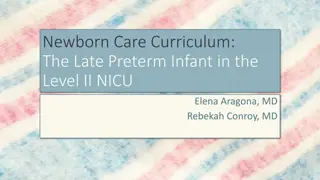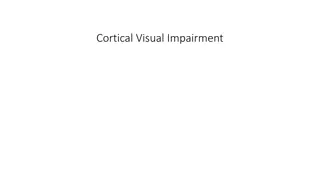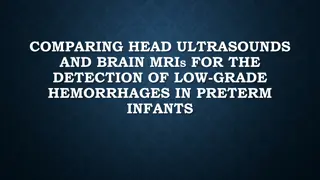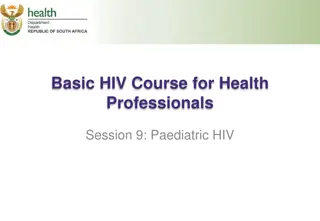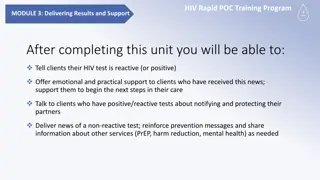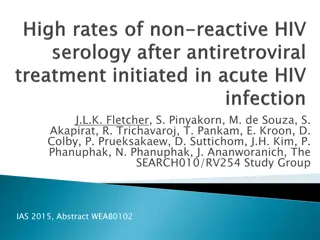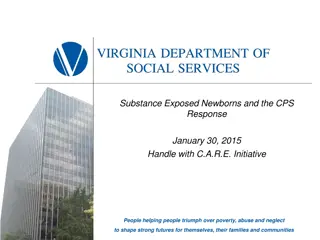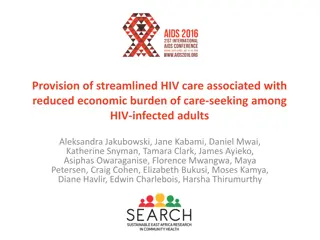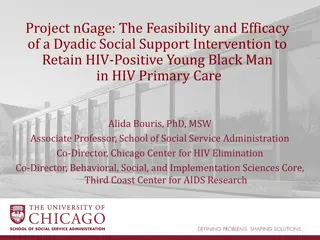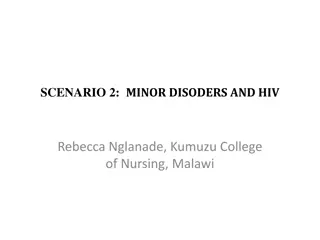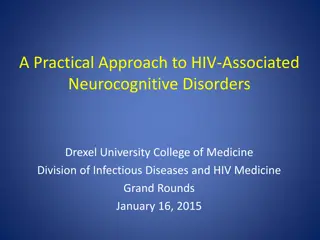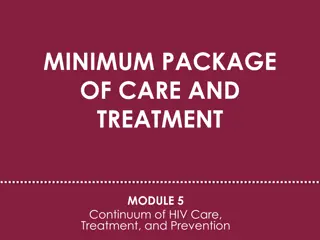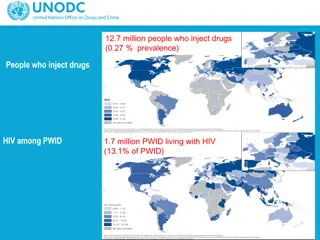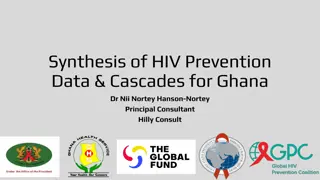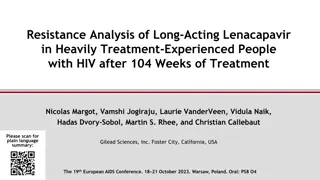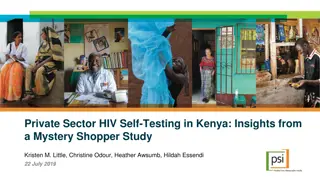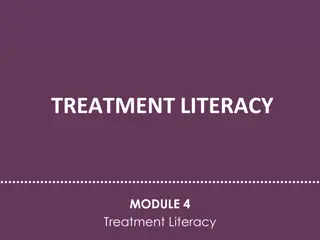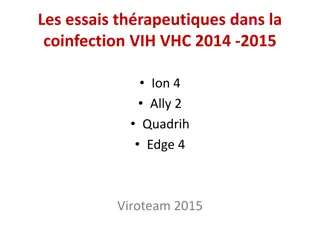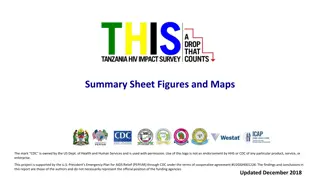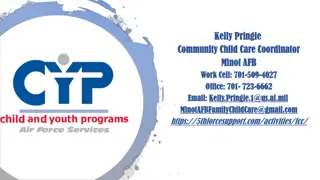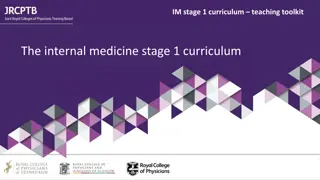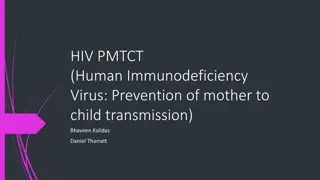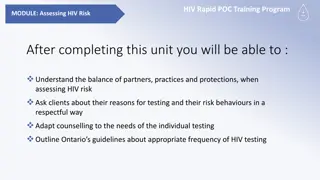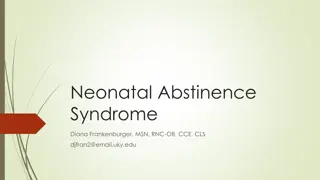Comprehensive Care for HIV-Exposed Infants Training Curriculum
Explore the comprehensive care training curriculum for healthcare providers focusing on key components of caring for HIV-exposed infants. Learn about administering ARV prophylaxis, recognizing HIV infection symptoms, and ensuring maternal health. Discover initiatives to expand and improve HIV testing for infants within a comprehensive care framework.
Download Presentation

Please find below an Image/Link to download the presentation.
The content on the website is provided AS IS for your information and personal use only. It may not be sold, licensed, or shared on other websites without obtaining consent from the author. Download presentation by click this link. If you encounter any issues during the download, it is possible that the publisher has removed the file from their server.
E N D
Presentation Transcript
Module 3 Module 3 Infant HIV Testing Comprehensive Care for HIV Comprehensive Care for HIV- - Exposed Infants Exposed Infants Training Curriculum for Healthcare Providers
Session 3.1 Comprehensive HIV-exposed Infant Care Session Objectives Describe the key components of comprehensive care of the HIV-exposed infant Provide support to caregivers of HIV-exposed infants to administer infant ARV prophylaxis from birth to 6 12 weeks of age Provide support to caregivers of HIV-exposed infants to administer co- trimoxazole prophylaxis Recognize the signs and symptoms suggestive of HIV infection in infants Understand the importance of the mother s health and HIV care, including good adherence to ART and viral suppression
Overview of HIV Overview of HIV- -exposed Infant Care exposed Infant Care How is the care for HIV-exposed infants different from care for non- HIV-exposed infants?
Overview of HIV Overview of HIV- -exposed Infant Care exposed Infant Care Initiatives to expand & improve infant HIV testing need to: Be part of a comprehensive package of care from birth through the breastfeeding period Ensure HIV-infected infants are immediately linked to ART A comprehensive approach maximize the chances of: Ensuring all HIV-exposed infants are tested by 4 6 weeks Receiving comprehensive care and testing services throughout breastfeeding, and Having a final HIV status at either 18 months of age or 3 months after breastfeeding (whichever is later)
Comprehensive Package of Care 1. Identification of HIV-exposed infants and infant HIV testing at:* 4 6 weeks of age 9 months 18 months or 3 months after cessation of breastfeeding (whichever is later) Immediate initiation of ART for those identified as infected *Some sites/countries have introduced birth testing in addition to the testing listed above If birth testing is provided, 4 6 week testing is still important
Comprehensive Package of Care 2. Preventive medical care Infant ARV prophylaxis: Daily medication to prevent HIV infection from birth to 6 12 weeks of age Infants considered high risk should receive enhanced postnatal prophylaxis (discussed later) Support to administer infant ARV prophylaxis Cotrimoxazole prophylaxis: Daily medication from 4 6 weeks of age until final HIV status is established Prevents illness and death due to diarrhoea, malaria and pneumonia TB screening and TB preventive therapy: IPT if infant does not have active TB but has known contact with a person with TB
Comprehensive Package of Care 3. Routine infant care Immunizations: It is particularly important for these children to be immunized completely and on time Provide the same immunizations for HIV-exposed/infected infants as for those who are not exposed Except infants who are known HIV-infected or have signs/symptoms of HIV should not receive BCG Note: HIV-exposed infants not known to be HIV positive or not born with signs of HIV should receive BCG vaccine Growth monitoring and nutritional support Developmental screening Infant feeding counselling to promote exclusive breastfeeding for the first 6 months
Comprehensive Package of Care 4. Family care and support Ensure maternal ART adherence and maternal viral suppression Psychosocial support and caregiver counselling and education on postnatal care and HIV-exposed infant services Family HIV testing: Sexual partners and other biological children Male partner engagement in health care services Family planning 5. Community linkages with referrals to support systems and support groups 6. Tracking of mother-infant pair for missed appointments and loss to follow-up
Comprehensive Care: Additional Considerations Integration into child immunization services: the comprehensive package of care can occur on the same schedule as immunizations & routine growth monitoring Linking mother and infant care: The care of the breastfeeding infant should be linked to the care of the mother Optimal outcomes for baby are dependent on mother s health Maternal adherence on ART prevents HIV transmission in the current and future pregnancies Adherence to care and patient tracking: It is important that HIV-exposed infants: Attend all clinic visits Are provided with focused examinations at each visit Are provided with counselling to support safe feeding Those who miss appointments should be tracked
Infant ARV Prophylaxis Infant ARV Prophylaxis It is important that HIV-exposed infants receive ARV prophylaxis: It protects against exposure to HIV during childbirth and early breastfeeding Provide even when the mother received ART during pregnancy Infant prophylaxis is particularly important if: Mother received limited, disrupted, or no ARV drugs during pregnancy or When viral suppression has not yet been achieved
ARV Prophylaxis for HIV ARV Prophylaxis for HIV- -exposed Infants exposed Infants Scenario Recommendation Breastfed: Once daily NVP For 6 weeks Infants born to women with HIV who: Have received 4 or more weeks of ART at the time of delivery OR Have a viral load (VL) 1000 in the 4 weeks before delivery Formula fed: Once daily NVP OR Twice daily AZT For 4 6 weeks
ARV Prophylaxis for HIV ARV Prophylaxis for HIV- -exposed Infants exposed Infants Scenario Recommendation High risk infants, i.e., infants born to women with HIV who: Received less than 4 weeks of ART at time of delivery or no ART OR Have a VL >1000 copies/mL in the 4 weeks before delivery High risk infants also include those: Born to women with incident HIV infection during pregnancy or breastfeeding, OR Born to women diagnosed with HIV at delivery or postpartum Breastfed: Twice daily AZT + once daily NVP for 12 weeks OR Twice daily AZT + once daily NVP for 6 weeks then once daily NVP for total of 12 weeks Formula fed: Twice daily AZT + once daily NVP For the first 6 weeks of life See Table 3.2, for simplified dosing of NVP and AZT for infants
Infant ARV Prophylaxis If a mother has ongoing poor ART adherence and high viral load beyond 12 weeks post-partum: Consider continuing infant ARV prophylaxis beyond 12 weeks of age in accordance with national guidelines Intensify efforts to address maternal ART adherence Assess for treatment failure
Infant ARV Prophylaxis, Scenario 1 You are counselling a breastfeeding mother who started ART 2 weeks after delivery. Is her infant at high risk of acquiring HIV? For how long should she provide ARV prophylaxis to her infant? What would be the infant ARV prophylaxis regimen of choice for this woman s infant?
Infant ARV Prophylaxis, Scenario 2 You are counselling a breastfeeding mother who started ART during her second trimester of pregnancy. No VL test was done in her last trimester. Is her infant at high risk of acquiring HIV? For how long should she provide ARV prophylaxis to her infant? What would be the infant ARV prophylaxis regimen of choice for this woman s infant?
Infant ARV Prophylaxis, Scenario 3 You are counselling a formula feeding mother who started ART 2 weeks before she delivered her baby. Is her infant at high risk of acquiring HIV? For how long should she provide ARV prophylaxis to her infant? What would be the infant ARV prophylaxis regimen of choice for this woman s infant?
Infant ARV Prophylaxis, Scenario 4 You are counselling a breastfeeding mother whose date of ART initiation is unclear on her health card and medical record, but you notice a lab test dated last month that says her VL was undetectable at delivery. Is her infant at high risk of acquiring HIV? For how long should she provide ARV prophylaxis to her infant? What would be the infant ARV prophylaxis regimen of choice for this woman s infant?
Please refer to country Child Health Card/Booklet and identify where to record information on infant ARV prophylaxis Child Health Card
Co Co- -trimoxazole Prophylaxis trimoxazole Prophylaxis Does anyone routinely prescribe co-trimoxazole prophylaxis? How do you counsel them about co-trimoxazole prophylaxis? Why is it important for them to take co-trimoxazole prophylaxis? What are some common challenges encountered when giving cotrimoxazole prophylaxis to patients? How do you deal with these challenges?
Co Co- -trimoxazole Prophylaxis trimoxazole Prophylaxis Co-trimoxazole prophylaxis is recommended for all infants and children who are HIV-exposed Continue until child is confirmed HIV-uninfected at least 3 months after the cessation of breastfeeding Co-trimoxazole is a fixed-dose combination of 2 antimicrobial drugs that can prevent bacterial, fungal and protozoan infections, including malaria If the infant becomes HIV-infected: Co-trimoxazole can also prevent life-threatening illnesses, such as PCP Co-trimoxazole is safe and well-tolerated Most infants have minimal or no side effects
Co Co- -trimoxazole Prophylaxis trimoxazole Prophylaxis Initiate co-trimoxazole prophylaxis in all HIV- exposed infants at 4 6 weeks of age
When Initiating Co When Initiating Co- -trimoxazole trimoxazole Counsel mother on possible side effects If the child has a severe rash with skin blistering, peeling, or sores in or around the mouth/eyes, stop IMMEDIATELY and take child to hospital Cotrimoxazole rarely causes Stevens-Johnsons syndrome which is a dangerous and should be evaluated immediately by a clinician Co-trimoxazole can be dosed based on age or weight. Use the dosing regimen recommended in national guidelines See Table 3.3 for weight-based dosing
Adherence Support Adherence Support How do you support your clients to remember to give medicine to their infants or children every day? What support do you think mothers need to give the correct dose, every day?
Adherence Support: Adherence Support: Prepare mothers before Prepare mothers before initiating infants on medications initiating infants on medications Discuss: Name of the drug their infant will be starting & dosage Why their infant needs to take this medication How long the infant will be on the medication Side effects and what to do if these side effects are experienced Drug storage How to get more medication/refills How they will remember to administer the medications every day What to do if a dose is missed What to do if infant doesn t want to take the drug/spits up the medication
Adherence Support Adherence Support Ask the caregiver: What concerns do you have about giving medicine to your baby? Who else might be administering these medications? What other medications, traditional or from a clinic, is the baby taking?
Adherence Adherence Messages Messages IT IS IMPORTANT TO MAKE AN ADHERENCE PLAN FOR YOUR BABY If you are taking medicines, give your child medicines at the same time you take yours. Try to schedule your own and your baby s appointments on the same day. Get support from someone you trust. Here are some tips on giving your baby syrups:* Look at the coloured tape/marking on the syringe to make sure you are giving the right dose. You can reuse syringes until the markings begin to wear off or the plunger is hard to use. Wash the syringes with warm, soapy water, rinse, and let them air dry. If the medicine is too sticky, add a little breast milk or formula to the syringe. DO NOT add medicines to a baby bottle or cup of milk. If your baby does not want to take his or her medicine, here are some tips:* Wrap your baby in a blanket and hold him or her in the bend of your arm. Place the dropper in the corner of the baby s mouth and slowly give the medicine. Aim for the inside of the baby s cheek instead of the back of the tongue. Blow gently into your baby s face, which should make him or her swallow. Do not give medicine when your baby is crying or by pinching his or her mouth open. See Appendix 3B: Key Adherence Messages for Caregivers See also: Appendix 3C: Adherence Support Guide & Appendix 3D: Adherence Assessment Guide If your baby vomits medicine within 30 minutes of giving it, give the dose again.
Provide Support to Mothers Provide Support to Mothers Mothers living with HIV will need support at every clinic visit to ensure that they are giving co-trimoxazole and/or infant ARV prophylaxis: At the right dose Every day, without fail Ask the mother: Most people have some difficulty taking all of their medications all of the time, can you tell me how many doses of your baby s medicine (ARV prophylaxis or co-trimoxazole) you gave to her yesterday? How about the day before yesterday? And the day before that? Can you show me how you give the medications to your baby?
Consider Other Issues Affecting Adherence Has the mother disclosed her HIV status to her partner or others in the home? Do others in the home know that the infant is taking medication and why? Who is responsible for giving the medication? If the mother is sometimes away, who else is responsible for giving medication? Do other caregivers understand the purpose of the medications? Provide supportive, respectful counselling to the caregiver Offer support for disclosure to partner or others in the home
Missed Doses If a dose of co-trimoxazole, nevirapine or zidovudine is forgotten: If within 4 hours of forgotten dose: Take the missed dose If it has been more than 4 hours, skip the missed dose and continue regular dosing schedule Do not take a double dose to make up for a missed one
Recognizing Signs or Symptoms of HIV Recognizing Signs or Symptoms of HIV Infection Infection Every clinical encounter should include a history and physical exam to determine if the HIV-exposed infant has any signs and/or symptoms of HIV infection What do you think is meant by signs or symptoms suggestive of HIV infection ?
Recognizing Signs or Symptoms of HIV Recognizing Signs or Symptoms of HIV Infection Infection Signs or symptoms suggestive of HIV: Malnourished, underweight, failing to thrive (not gaining weight) Poor milestone development (delay in reaching milestones, or losing milestone) Present with severe, recurrent or unusual infections Diagnosed with TB
Recognizing Signs or Symptoms of HIV Recognizing Signs or Symptoms of HIV Infection Infection If NAT is unavailable or delayed, make a presumptive diagnosis of HIV if infant: Has positive serology (RDT) Presents with signs and symptoms of HIV Provide (or refer for) further evaluation and treatment as soon as possible Do not delay referral of a sick baby while waiting for a test result Waiting too long to treat an HIV-infected infant may result in the infant s death Review Appendix 3E: Criteria for presumptive diagnosis of severe HIV disease in infants and children.
Mothers Health and Family Support Mother s Health and Family Support Do you work in a setting where mothers and infants are seen together as mother-infant pairs? If so, what are the benefits and challenges? During an infant clinical visit, what do you ask parents to enquire about their own health? If only one parent is in attendance with the baby, for example the mother, what do you say to enquire about the partner?
Mothers Health and Family Support Mother s Health and Family Support The care provided to infants must consider the infant s family environment The health of the family is important to the health of the infant At each follow up visit, ask mother about her health If a mother is sick on ART, evaluate for treatment failure using VL Infants of mothers with high VL are at high risk of acquiring HIV If possible, see the mother and infant together at the same appointment
Ask Mothers with HIV About Ask Mothers with HIV About Their own health Enrolment in care and treatment for their HIV infection. If not yet enrolled in care, initiate care and treatment today or provide referrals and ensure she is accompanied to the referral Adherence to their ART regimens; provide support Mother s VL Adherence to their infants ARV and/or or co-trimoxazole prophylaxis regimens Remind mothers that the infant dose will need to be adjusted as the baby gains weight
Ask Mothers with HIV About Ask Mothers with HIV About Disclosure: Does your partner know your HIV status? Partner s health: Has your partner been tested for HIV? If HIV-infected, is he enrolled in care? Is he taking ART? Partner involvement: Would your partner accompany you to the baby s next visit. If not, why not? Does your partner support you in exclusively breastfeeding your baby, providing medicine to your baby, attending regular clinic visits, etc? Health of other children: Have your other children been tested? If children have not been tested, make a plan to test the other children Community or health facility-based services such as psychosocial support, food provision, safe water system provision Provide referrals
Checklist for HIV-exposed Infant Care Refer to Appendix 3A: Checklist for HIV-exposed Infant Care to summarize this session
Session 3.2 Growth Monitoring and Infant Feeding Session Objectives Understand the importance of monitoring growth, development and immunizations for HIV-exposed infants Understand the HIV-exposed infant and young child feeding recommendations
Introduction to Growth Monitoring and Infant Introduction to Growth Monitoring and Infant Feeding Feeding Routine growth monitoring & infant feeding counselling session are key components of the routine child visit Poor growth can be one of the first indications that a child is HIV-infected It can indicate problems with infant feeding Growth monitoring is the same whether measuring an HIV- exposed, HIV-infected, or an HIV-uninfected child Accurate measurements are essential parts of the health evaluation
Introduction to Growth Monitoring and Infant Introduction to Growth Monitoring and Infant Feeding Feeding This module is an overview of the process, under the assumption that most learners are familiar with key concepts This is not a full training on growth monitoring and nutritional screening It is particularly important to ensure growth of HIV- exposed children is assessed at every routine and sick child visit Poor growth can be a sign of HIV infection; consider HIV testing for HIV-exposed infants with poor growth
Growth Monitoring Growth Monitoring Key steps in growth monitoring: Record/confirm the child s name, sex and date of birth Determine the child s age as of today s date Remove all clothing, make a visual assessment, and evaluate for oedema. If the child has oedema, make note Complete the growth assessment and refer immediately to a clinician This child may have severe malnutrition Weigh the child Measure the length (for children < 2 years) or height (children > 2 years) Measure head circumference If the child is between 6 60 months of age, measure MUAC
WHO Child Growth Standard (an example)
Growth Monitoring Use the child s growth standard/chart to: Plot weight and length/height at every visit Assess if child is growing normally Follow national guidelines for measuring growth; head circumference and MUAC may be recommended as well Weight gain should consistently follow one of the growth lines If not, intervene immediately If growth has slowed: Ask questions about feeding and recent illness Provide infant feeding counselling and provide support to follow that advice If child meets criteria for acute malnutrition (moderate or severe), refer for nutritional support according to national guidelines
Infant and Young Child Feeding Infant and Young Child Feeding What are the national recommendations for feeding of HIV-exposed infants? How can risk of HIV transmission by breastfeeding be minimized?
Infant and Young Child Feeding (IYCF) Infant and Young Child Feeding (IYCF) Provide infant and young child feeding counselling and support at every visit, even if the child is growing normally Infant and young child feeding counselling and support is particularly important for infants who are HIV-exposed These children are at higher risk of malnutrition, even if not HIV-infected
IYCF: Global Recommendations IYCF: Global Recommendations Whether HIV-exposed, infected or uninfected, WHO recommends: Breastfeed exclusively for the first 6 months of life Introduce appropriate complementary foods at 6 months of age Mothers with HIV should continue breastfeeding for at least 12 months, or 24 months or longer Note: The recommendation to breastfeed for up to 24 months or longer, assumes that mother will have: Lifelong ART, including adherence counselling Infant feeding counselling and support
IYCF: Global Recommendations If the mother is not on ART or has poor ART adherence, health care providers: Discuss the feeding options and HIV transmission risk so she can make an individual plan Breastfeeding should stop only once a nutritionally adequate and safe diet without breast-milk can be provided Infants who are HIV infected benefit from extended breastfeeding and should continue breastfeeding for as long as feasible and desired
IYCF: Global Recommendations ART lowers risk of HIV transmission through breast milk Breastfeeding women who are taking ART as recommended have a very low risk of transmitting HIV to their infants through breast milk In many settings, the risks associated with not breastfeeding (i.e., diarrhoea, pneumonia and malnutrition) are much greater than the risks associated with breastfeeding (i.e., risk of acquiring HIV from breastmilk), especially when the mother is on ART and virally suppressed
Breastfeeding Mothers If breastfeeding observe a feed, check attachment and positioning, provide support Ensure mother is taking ART every day Advise her on the risk of transmitting HIV to her infant through breastfeeding Remind her that she can minimize this risk by taking her ART, as prescribed Test mother s VL according to national guidelines Routine VL testing, as well as targeted testing if mother is ill VL testing ensures ART is suppressing the virus
Breastfeeding Mothers Support mothers to breastfeed exclusively in the first 6 months of life EBFin the first 6 months of life reduces the risk of death from diarrhoea, pneumonia and malnutrition among babies During the first 6 months: no porridge, cow milk, juice, infant formula, or other foods or liquids Note: EBF pertains only to the first 6 months of life
